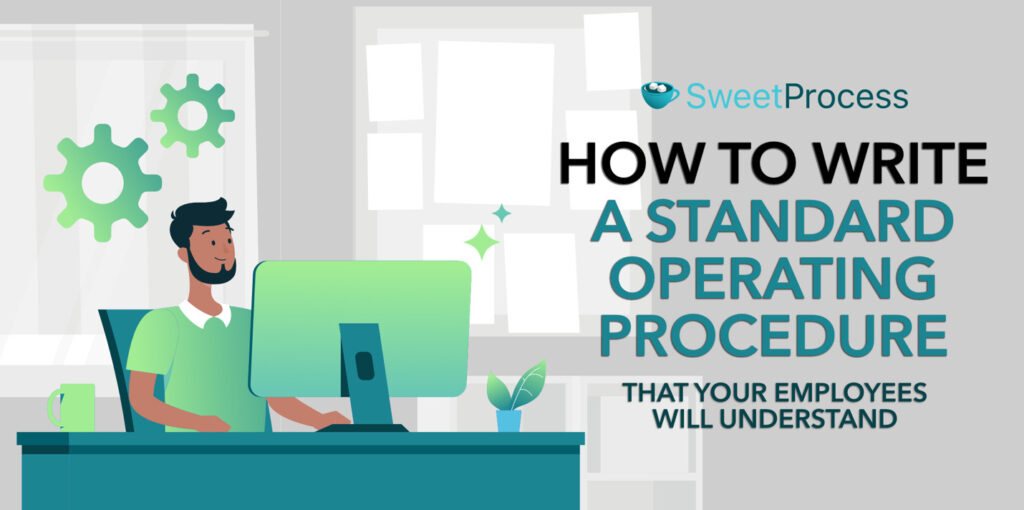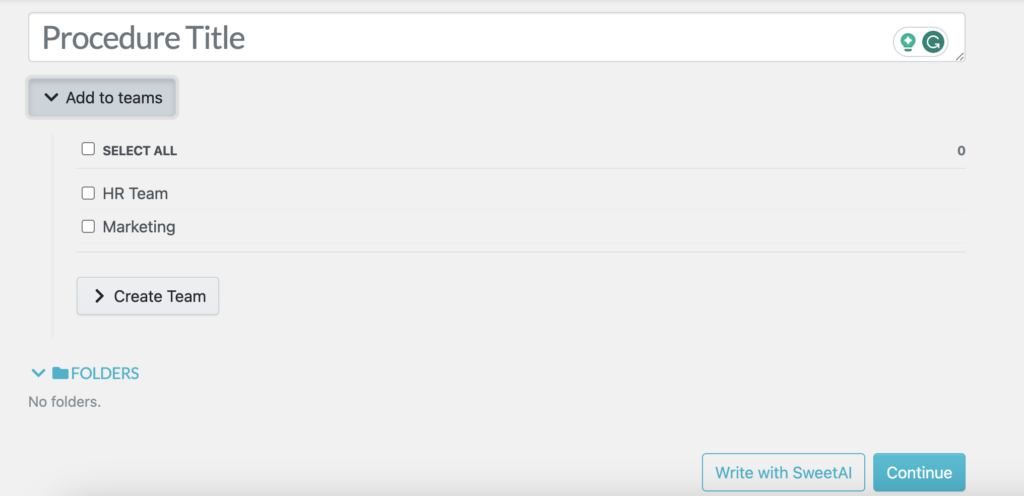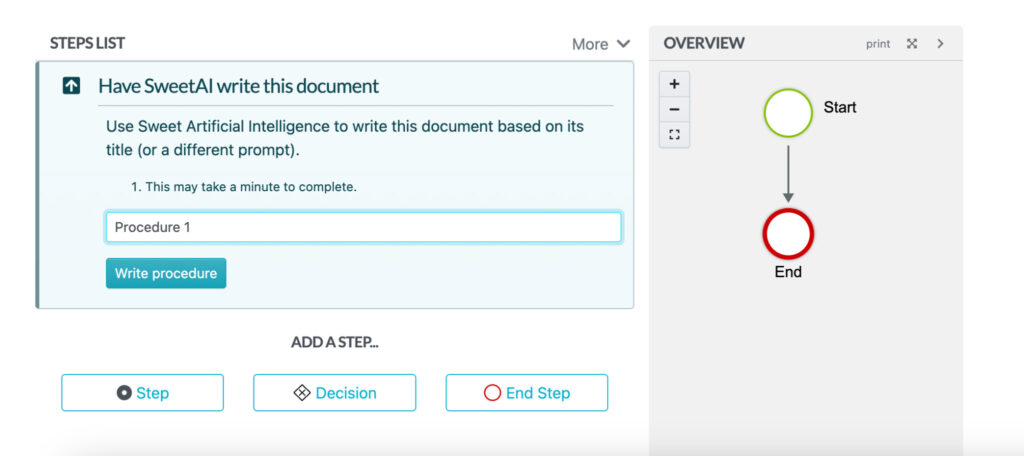Last Updated on July 11, 2025 by Owen McGab Enaohwo

Efficiency and consistency are the lifelines of any successful business. To achieve these goals, you need well-defined standard operating procedures (SOPs) to serve as a reliable roadmap for your employees, providing them with step-by-step instructions to perform tasks accurately. However, this is not always the case.
Some organizations encounter challenges in creating SOPs that resonate with employees. For instance, if your SOPs have complex jargon and overwhelming details, they could easily confuse your employees. When this happens, your staff will ask the same questions about work-slowing operations.
To bridge this gap, this article will equip you with practical tips and insights to write SOPs that your employees will grasp effortlessly.
You can empower your team to excel in their roles by writing SOPs that are easy to understand using SweetProcess. Start the 14-day SweetProcess free trial today. No credit card is required!
Table of Contents
What Is a Standard Operating Procedure (SOP)?
How to Write a Standard Operating Procedure (SOP) in 11 Steps
How to Write Standard Operating Procedures Using SweetProcess
Standard Operating Procedure (SOP) Formats
Challenges of Creating a Standard Operating Procedure (SOP)
Industries That Use Standard Operating Procedures
FAQs on How to Write a Standard Operating Procedure (SOP)
What Is a Standard Operating Procedure (SOP)?

A standard operating procedure (SOP) is a documented set of step-by-step instructions detailing how employees should carry out their tasks or processes. It should be an easy-to-understand document with all routine operations to ensure the company is efficient and consistent.
The SOP is a reference guide for all departments, including who is responsible for which tasks, the procedures to be followed, and the deadlines for each deliverable. Additionally, it can incorporate relevant details such as safety guidelines, templates, and troubleshooting tips helpful in industries requiring standardization.
Why is a Standard Operating Procedure Important?
Whether hiring new employees or training the existing ones, you need a standardized system of doing tasks. Implementing SOP Training ensures that everyone understands and follows the same procedures, reducing confusion and errors. Your operations could slow down significantly if your employees don’t have a proper guide on executing their work. This is why you need SOPs in your organization..
Let’s look at why SOPs are essential.
Adherence to Best Practices
Adhering to regulatory requirements and industry standards is a cornerstone of operational success in any organization. For example, in manufacturing, safety guidelines dictate not only how employees should work on the production floor but also the type of safety equipment they must use. To ensure compliance with such standards, implementing SOP best practices is essential.
Standard Operating Procedures (SOPs) serve as a framework for creating clear, actionable guidelines that employees can follow consistently. By defining the purpose, scope, and step-by-step instructions of each task, SOPs reduce errors, enhance safety, and minimize the risk of non-compliance. For instance, incorporating visual aids like flowcharts or diagrams can make complex processes easier to understand and implement effectively.
Consistency and Efficiency
Do you want to keep your customers happy? Then, you need to maintain consistency. According to a survey, about 46% of the respondents shared that consistency is one of the critical factors if you want to create a positive customer experience.
SOPs help ensure that tasks and processes are carried out in the same sequence to maintain the quality of products and services. Employees will have specific guidelines to follow, eliminating variation in performance and enhancing efficiency. With this documentation, your output will be the same even if you have teams in different shifts or locations.
Quality Assurance
Maintaining quality is critical if you want to meet customer expectations. SOPs can boost your organization’s quality standards and simplify complex procedures. In addition, they can help you identify any potential issues in your tasks at each stage and correct them before they affect your overall productivity.
Your team members can always refer to the SOPs to standardize their work. This reduces the likelihood of service failures. Additionally, these procedures establish solid protocols, especially if your organization needs to meet customer expectations. A dedicated manual creator can help develop these SOPs efficiently, ensuring they’re comprehensive and easy to follow.
Proper Onboarding and Training
Research by Zippia shows that 92% of employees say training programs positively affect their performance and work involvement when well planned. You should consider developing proper structures to help with employee training.
SOPs are an excellent resource for knowledge transfer. When you hire a new employee, a structured intake process ensures they receive the necessary resources to understand their role and responsibilities. SOP documents are a valuable tool, providing an overview of tasks and expectations.
These SOPs can be packaged as training materials for new hires and employees transitioning into different roles within the company. They outline essential procedures, safety protocols, and performance standards, fostering accountability by clearly defining expectations. Additionally, having these documents readily available allows team members to access company information independently, reducing reliance on managers and supervisors for guidance.
Maintaining Organizational Knowledge
As experienced employees retire or move on to other roles, SOPs ensure their expertise and insights are not lost. They capture and preserve institutional knowledge within an organization.
As a repository of documented procedures, they empower employees to continue operations seamlessly. Everyone can refer to the company’s best practices to continuously improve operations.
Standard Operating Procedure (SOP) Examples
Not sure how SOPs work? Here are some examples to get you started:
Example: An SOP for Customer Service Response
| Subject: Addressing customer inquiries and resolving issues promptly. Date: 07/17/2023 Prepared by: Jane Moore Approved by: Sam Martin 1. Acknowledge the customer’s email within 24 hours. 2. Express gratitude for their inquiry and request additional information to understand the issue fully. 3. Review the customer’s email thoroughly to understand the nature of the inquiry. 4. Research using available resources, such as product information and knowledge base, to gather relevant information. 5. Analyze the situation to identify the root cause. 6. Craft a detailed and personalized response to address the customer’s concern. 7. Using simple and concise language, provide a clear explanation or instructions to resolve the issue. 8. Include relevant support documentation, such as user guides or troubleshooting steps. 9. Monitor the customer’s response and provide additional assistance if required. 10. Document the interaction and the detailed steps taken in the customer relationship management (CRM) system or any designated tracking tool. 11. Flag any recurring or complex issues for further analysis or escalation. 12. Update the knowledge base or FAQ section with new insights or solutions. |
Example: Inventory management
| Subject: Managing inventory levels 1. Receive the shipment from the supplier. 2. Verify the received goods against the packing list. 3. Inspect the items for any damage or discrepancies. 4. If significant discrepancies are found, notify the appropriate personnel, such as the warehouse manager or purchasing department. 5. Assign a unique identifier to each item. 6. Update the inventory management system with the new stock details. 7. Organize the items in a logical and accessible manner. 8. Regularly update the inventory management system to reflect stock movements. 9. Monitor inventory levels to identify low-stock situations. 10. Communicate with the purchasing department or relevant stakeholders to ensure timely procurement. |
What Should an SOP Include?
You need to curate SOPs for each of your company’s departments. If you want to create an effective SOP, here are the key things you should include:
- Title of the SOP
- Company department
- Purpose or objective of the SOP
- Scope of the SOP
- Definitions and terminologies
- Responsibilities
- Detailed procedure descriptions
With this basic outline, you can build a comprehensive SOP Format for your employees.
How to Write an Effective Standard Operating Procedure (SOP) in 11 Steps

Writing an SOP requires proper planning, research, and coordination. You must develop a comprehensive guide for your employees to follow as they perform their routine tasks. You need a fully functional SOP document in a centralized location to effectively manage your operations.
Here are the steps you can follow to write a comprehensive SOP:
Step 1: Begin With the End in Mind
Before writing an SOP, it’s crucial to understand the desired outcome clearly. You need to define your end goal to keep your SOP focused. For instance, if you’re writing an SOP that describes the procedures for handling customer complaints, your company’s objective is to resolve any issues and improve customer satisfaction and retention.
You can create an SOP document to identify the issues that must be addressed. Alternatively, if you already have SOPs, you can review them and improve weak areas to better meet the customer’s needs. This way, you don’t have to spend money and resources on a procedure manual you don’t need.
An end goal allows you to outline the key steps for your company procedures.
Step 2: Determine the Scope and Format of the SOP
With a clear purpose in mind, you can now define the scope and format of your SOP. The scope is essential, especially if you have overlapping tasks in different company departments. Consider the extent of the process or task you want to document and decide whether you’ll create a comprehensive SOP that covers every detail or a more focused one that addresses specific aspects.
Additionally, you need to choose your preferred format. Your operations manual should be easy to scan. If your organization has created SOPs in the past, you likely have a format already. If the current format is perfect, you don’t have to create a new one. However, if it’s confusing to your employees, you need to work on a new one.
Some of the best formats are pretty visual. Depending on your organization, you can list all the steps or map them out in a flowchart or diagram.
Step 3: Gather All Information
As you write the SOP, it’s important to remember that you don’t know everything. Whether you are a supervisor or a manager, you still need the team members’ input who perform the day-to-day activities. The other employees might have some key information that needs to be included in the SOP.
Invite your entire team and departments to contribute to problematic areas that must be focused on. For instance, if you are working on improving the handling process for customer complaints, you need to interview customer service representatives and gather information from previous complaints to get proper insights.
Your employees are experts on the subject matter; therefore, you need them to create a well-informed SOP.
As you gather input, you might need to draft multiple copies and keep reviewing them as you get more details.
Step 4: Define Your Objectives for Creating an SOP
You also need to establish the specific objectives you aim to achieve by creating the SOP. These objectives could be related to improving efficiency, ensuring consistency, enhancing quality, minimizing errors, promoting safety, or any other relevant goals. Clearly defining your objectives will guide the content and structure of the SOP.
They will also serve as a framework for the subsequent steps. Clearly articulate what you want the team to achieve using a specific SOP for the best results.
Step 5: Determine the Stakeholders and Creators
Drafting the SOPs involves several people. You must identify the key team members involved in the SOP creation process. This could include subject matter experts, department managers, team leaders, and other relevant parties.
For instance, if your SOP is on inventory management, you must involve the logistics, transport, warehouse, procurement, and warehousing teams. Additionally, you must assign responsibilities to each stakeholder and establish a clear communication plan to ensure collaboration and feedback throughout the SOP development. Each stakeholder will contribute their expertise and perspective to ensure a well-rounded SOP.
Step 6: Identify Your Audience
Knowing your audience will help you greatly in the SOP writing process. Take time to consider who will be using the SOP and tailor the content and language accordingly. You can identify your audience by determining their level of education, prior knowledge, and whether they’ll understand the terminologies in the procedure document.
Once you understand this, you can word the SOPs much better. Ensure that the information is broken down in the simplest way possible to make it easy to understand. One of the ways to do this is by adding visuals. This will help you communicate effectively and ensure the SOP is easily understandable and actionable.
Ensure that the SOPs accommodate all departments and employees. They should also be adequately tailored as a training guide for new hires and existing team members seeking a refresher on the process.
Step 7: Outline the SOP Document—and Begin Writing It
Create a clear outline for your SOP, breaking down the process into logical sections and steps. This outline will serve as a roadmap for effective writing of the SOP, ensuring that all relevant information is included and organized in a structured manner.
To write, include the following:
Title Page
The title summarizes the theme of your SOP document.
Table of Contents
This section outlines all the sections and subsections of the SOP. Your audience can use the table of contents to navigate the document and locate the necessary sections quickly.
The Specific Procedures
This is the main part of your SOP. It includes step-by-step instructions for all the procedures in clear language. For better understanding, it can be in list form or have visuals such as flowcharts.
Preparatory Information
Add any necessary background information or prerequisites your readers should know before executing the procedures. This section can include safety precautions, equipment setup, or any other tasks.
Methodology and Procedures
You must be explicit and provide specific instructions for your team. For instance, in production, you must include any relevant tools or measurements the team should use. Alternatively, you can add time frames for tasks to ensure clarity and ease of comprehension.
Quality Control and Assurance
This section describes the quality control measures to ensure the accuracy and integrity of the process. Outline specific quality standards that need to be maintained. You can add details like audits, periodic reviews, or verification steps.
References and Glossary
Add a list of references such as industry standards, regulations, and other external documents that were consulted during the creation of the SOP. Furthermore, you need a glossary of terms and definitions to clarify any technical or specialized terminology used throughout the document.
Step 8: Review Your SOP
After completing the initial draft of your SOP, conduct a thorough review to ensure accuracy. Share the draft with your team members, experts, and other stakeholders. This way, you can gather feedback and incorporate any suggestions.
For instance, if you are working to improve the customer service in your business, engage the customer service managers to help you identify any additional steps that need to be added.
Additionally, you need to talk to legal or compliance experts in the company to ensure that the document aligns with the set regulations.
Step 9: Train Your End-Users
Now that you’ve written down the SOPs, the work does not end there. You need to train your end-users on how they’ll be executing the tasks outlined. Organize training sessions with all the departments to explain the purpose of the SOP, the specific procedures, and how to follow them accurately.
These sessions allow you to offer clarification and answer any questions that arise. The training can include case studies and simulations to ensure employees understand.
Step 10: Test and Tweak the SOP in Practice
Testing the SOP in practice helps evaluate its effectiveness. This is your chance to monitor the implementation of the procedures and gather feedback from end-users and stakeholders. During the testing phase, you can identify any challenges or areas for improvement and make necessary adjustments.
You can streamline key steps and provide additional training to enhance the effectiveness of your SOP.
Step 11: Implement SOP—Revisit Regularly and Update as Needed
Once the testing is done, you can start implementing the procedures in your organization. However, you must periodically revisit and update it to ensure its ongoing relevance and effectiveness.
Most industries experience changes in the regulations and processes that need to be updated. For instance, you might have new government regulations that must be followed. In this case, you must update the SOP document to reflect the latest best practices. Additionally, you might get more end-user feedback that may necessitate revisions.
- Want to write your procedure without going through these steps? You can customize these free downloadable policy and procedure templates for your use.
How to Write Standard Operating Procedures Using SweetProcess

SweetProcess is your go-to standard operating procedure software for explaining your company’s procedures to employees. It provides a knowledge base for your team, making it easy to accomplish tasks.
We also have several SOP templates that you can use. This allows you to create a standardized document quickly and include visual aids for your employees. Here’s how to write SOPs using SweetProcess.
- Log in to your SweetProcess account.
- Select the “Procedures” tab on the main dashboard.

- Click “Create Procedure” on the next tab.
- On the next page, add a procedure title.

- You can assign the procedure to specific teams by selecting an option.
- Add details to your procedure and assign them to specific teams.

On the next tab, you can add details of your procedure.
SweetProcess also allows users to write the SOP using the AI tool: SweetAI. You just need to add the title; the document will be generated in a few minutes.
SweetProcess has been a critical tool for some businesses that need to instantly generate their SOPs.
A good example is branch operations manager Sarah Beach and certified financial planner Elian Levatino, who are part of the leadership team at a financial advising firm, Benchmark Wealth Management.
As the business was expanding, it did not have universally accepted SOPs. This affected the quality of work in the organization because employees were not consistent in their tasks.
The organization used outdated methods by documenting all the processes in a notebook. Because of this, they had a challenge replicating uniform results. The company eventually discovered SweetProcess, which turned things around. They could now document all the procedures in a centralized place.
This made it easy to train and onboard new employees. Furthermore, they could now switch from notebooks to an automated documentation tool, making employees more independent.
Another SweetProcess client is Manny Cosme, CFO Services Group’s president and CEO. Initially, the organization did not have a standardized workflow, and the company documentation was disorganized. This affected the employee’s performance and prompted Manny to look for a proper documentation tool.
Since they started using SweetProcess, they now have a centralized knowledge base. It also became a go-to resource for his employees. Additionally, Manny can now focus on the company’s management because the employees can easily find information on SweetProcess. Sign up for a free 14-day trial of SweetProcess.
You can use several formats to write your SOP. While there’s no single way to write your procedure document, picking a structure to arrange the information is important.
Standard Operating Procedure (SOP) Formats

The format you pick should be based on the company’s requirements, the scope of work, and the nature of the process being documented. Some organizations may even employ a combination of formats to cater to different procedures and learning preferences.
Ensure you choose an SOP format that will not further complicate the process and confuse your employees. So, which formats should you use? Here are the main ones to help you make an informed decision.
Step-by-Step Written Format
If you are looking for a simple SOP format for your business, the step-by-step format is a good place to start. It’s the most commonly used format for writing SOPs because it’s direct and easier to create, especially for small businesses and teams.
This format sequentially presents instructions, describing each step in detail. It can also be used for complex company procedures that need precision. You can break down tasks in a simpler way for users to understand. These instructions are easy to follow without causing too much confusion.
Hierarchical Format
The hierarchical step format simplifies the tasks for employees to understand. However, the procedures are organized with main categories and subcategories. For instance, if your SOP is for incident response, you can have the first category as preliminary steps and subcategories like identification, assessment, and incident categorization.
This format is helpful when SOPs cover a wide range of processes or when users have different levels of expertise.
Flowchart Format
Flowcharts can be used to write SOPs when you need to simplify large and complex decisions in a logical format. This format represents the steps using arrows and graphical symbols. Although they require more writing time when creating shapes, they provide a visual representation when SOPs have several branches and alternative paths.
Using this format, you can plan the most effective path for all the procedures and add the possible outcomes. Additionally, the flowcharts can be designed based on the organizational structure for employees to follow according to their roles. On the other hand, they can be created depending on the company processes.
Checklist Format
The checklist format is also pretty direct because it presents the procedures as a list of items needing completion. To write SOPs in a checklist, you can add checkboxes to the steps to ensure that nothing is overlooked.
This format is helpful for tasks that require consistent adherence to a set of requirements or for quality control purposes. Your employees can just glance at the ticked tasks to get information about the task progress.
While these checklists are fine for small teams, you can’t add more outcomes or events like in a flowchart.
Video Format
Alternatively, you can write your SOPs using a video format. This involves recording the procedures as a visual demonstration for your employees. In some industries, some processes are better understood through practical demonstration, such as equipment operation or manual tasks.
Videos will capture details that may be difficult to convey through written instructions alone. For instance, a video demonstration can show the proper machine operation in a manufacturing company to reduce the chances of errors.
Interactive Course
An interactive course format combines various media elements, such as text, images, videos, and quizzes, to create a comprehensive learning experience. Through interactive assessments, your employees can engage with the content to assess their understanding.
This format is beneficial for training or when SOPs require a deeper understanding. In this format, you can use text-based lessons, quizzes to test knowledge, and scenario-based exercises where employees can execute a particular task.
Wiki/Collaboration
This format promotes knowledge sharing among your employees and staff. Using the wiki or collaboration format, you create a shared platform where multiple users can contribute, edit, and improve SOPs collaboratively.
With this, you can continuously improve procedures. This format is handy when SOPs require frequent updates or when multiple departments are involved. For instance, if you have legal and compliance experts on your team, they must provide information on the latest regulations.
Infographics
If you want to present your SOPs visually, try infographics. This format uses icons, illustrations, and charts to represent information visually, making it easy for the reader to understand and retain the key points. In addition, the text is simplified and presented in short, descriptive phrases or bullet points, complementing the visuals to enhance comprehension.
It also has color and design elements to make the charts or graphs more appealing. Infographics should be designed to be mobile-friendly for optimal accessibility. Use appropriate fonts, sizes, and spacing to ensure readability as you write in this format. Consider using arrows or other graphical elements to indicate the flow or sequence of the process steps.
Challenges of Creating a Standard Operating Procedure (SOP)

Although SOPs are beneficial to organizations, they come with a set of challenges. You need to be aware of them to help you write better SOPs.
Here are some of them:
Compartmentalized Development
SOP development should involve all teams, departments, and stakeholders. If you fail to involve some of the teams, your SOPs may not be as comprehensive as they should be. When the procedures are written by different teams or individuals within an organization, this leads to compartmentalized development.
If the SOPs are created only by the management team, there’s a higher chance that the other employees may encounter problems when executing tasks.
Management may miss some key steps required to accomplish company goals. In addition, this can result in inconsistencies, contradictions, and duplication of efforts when departments are not aligned.
Different departments may have their own processes and practices, making creating a unified and standardized procedure difficult. To avoid this, involve all stakeholders in the development process.
Problems With Accessibility, Visibility, and Centralization of Information
Once you develop your standard operating procedure document, you must ensure they are available to all stakeholders. Otherwise, if they are not easily accessible, your employees will still have the same problems when performing their tasks, leading to more inefficiency.
Additionally, it’s important to provide the same SOP documentation to all team members and company departments. To achieve this, you need a centralized repository or a system to ensure proper dissemination and easy access to SOPs. If you don’t have this, employees may struggle to find the most up-to-date versions or be unaware of their existence.
Lack of Management and Maintenance
You must remember that your SOPs require ongoing management and maintenance to ensure they remain up-to-date and relevant. However, organizations often face challenges with this, especially if the employees are not properly trained. If your team members lack the proper knowledge to complete the tasks defined, they may not implement the SOP accordingly.
Furthermore, some companies have difficulty regularly dedicating resources and time to review, update, and improve SOPs. You need to keep up with the increase in new technologies and other changes in the industry; otherwise, your SOPs can quickly become outdated, leading to confusion and errors in operations.
Inconsistencies
You could encounter inconsistencies with different departments or teams in multiple locations. This challenge arises due to differences in terminology, procedures, or approaches across departments or teams. For instance, the marketing department might have a different approach to doing things than the customer service team.
If each of them follows their direction, this can lead to confusion, inefficiency, and errors in operations. Harmonizing and aligning SOPs across the organization can be complex, especially in larger organizations with multiple divisions or locations.
Resource-Intensive Process
Developing comprehensive and effective SOPs requires significant time, effort, and resources. You have to analyze the existing processes and procedures to determine which ones to keep, improve or eliminate. On the other hand, you also need to involve stakeholders to get their input on different ideas.
This process can be resource-intensive, especially for organizations with limited resources or when SOPs must be created for a wide range of complex operations.
Industries That Use Standard Operating Procedures

You can write standard operating procedures for different sectors and departments. They cover a range of industries because procedures are necessary for almost every company task. Let’s look at some of these industry cases and SOP examples:
- Marketing: SOPs provide marketing companies with the necessary help they need to implement campaigns, develop social media content and strategies, or analyze marketing data.
- Financial: Organizations in this industry use SOPs to manage financial transactions for their clients and enhance operations.
A good example is Amy Walls, the president and financial advisor at Thimbleberry Financial. Her role involved leading a team of financial experts to help clients manage their business.
Amy created procedures on Microsoft Word to achieve this. However, this was ineffective because her employees could not access information to help with task execution.
She discovered that the team was not following the instructions on the Microsoft Word documents. They abandoned the tasks, and it became hard to track assignments. However, all this changed when her business coach introduced her to SweetProcess.
Now, the team can access all documentation in a centralized place, enhancing collaboration and streamlining the intake process for onboarding.
- Manufacturing: These companies use Manufacturing SOPs to outline the necessary steps employees should follow during safety protocols, quality control, and production processes.
- Customer service: If you are in this sector, you need SOP documentation to outline the procedures employees should follow when interacting with customers or addressing inquiries.
- Real estate: This industry experiences constant changes in the market. You need to constantly update the SOPs to keep your employees on track.
One of the people who has used SOPs in their real estate business is the managing director at All Residential Real Estate, Perry Beebe. The property management company initially used paper-based checklists, which were ineffective. They became outdated fast; therefore, employees did not have enough information to work efficiently.
Perry switched to a paperless documentation software, SweetProcess, to streamline his business operations. Since the switch, employees no longer rely much on experts for guidance. They can also use features like video to train and onboard new employees. Additionally, the company operations are more consistent. Sign up for a free 14-day trial of SweetProcess.
FAQs on How to Write a Standard Operating Procedure (SOP)

What is the difference between an SOP and a policy?
SOPs are step-by-step instructions that employees need to follow to execute their tasks on a day-to-day basis. On the other hand, policies are the overall framework that guides the overall team toward decision-making. They establish rules that everyone should follow when executing company processes and procedures.
What is an SOP checklist?
An SOP checklist outlines all the steps that employees need to follow. You can use it as a reference guide to verify that all the necessary actions have been fulfilled in the SOP. This is the best tool to help you maintain consistency and reduce errors.
What is the difference between an SOP and work instruction?
SOPs are broader in scope and provide a high-level overview of the task. They address everyone involved in the business processes. On the other hand, work instructions are specific and more detailed. They explain how a task needs to be achieved and address only the people entrusted with executing a specific task.
When to create an SOP
You can create an SOP during various stages. This can be when you have critical or complex operations, need to introduce new processes, meet regulatory changes, train and onboard new hires, or promote knowledge sharing.
How long should an SOP be?
The length of your SOP can vary depending on the complexity of the process or task being documented. While there is no strict rule on the exact size of an SOP, it should be concise and focused on providing clear instructions and guidance to the users.
